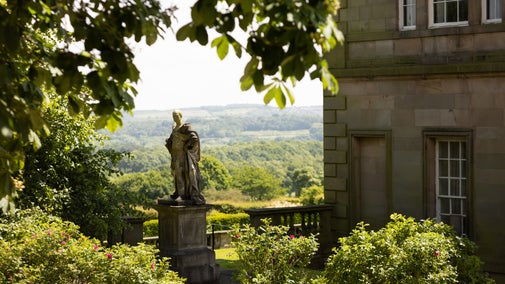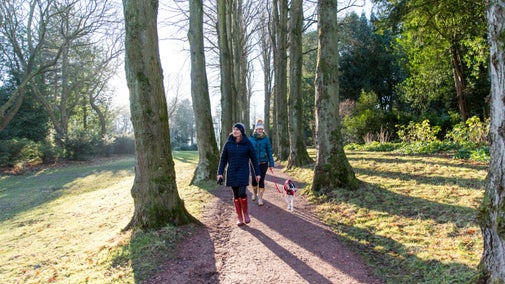
Discover more at Wentworth Castle Gardens
Find out when Wentworth Castle Garden is open, how to get here, things to see and do and more.

One of the most prominent 18th-century monuments at Wentworth Castle Gardens is an obelisk “dedicated to the Memory of the Rt Hon. Lady Mary Wortley Montagu who in the Year 1720 introduced inoculation of the smallpox into England from Turkey”. A testament to her impact, this commemoration is believed to be among the oldest monuments in the country dedicated to a non-royal woman.
Born into the aristocratic Pierrepont family, Lady Mary Wortley Montagu (1689–1762) is known today as a writer and poet, whose life reflected the privileges and pitfalls of being a fiercely intelligent, creative and ambitious aristocratic woman in England during the early 18th century.
She was an early adopter of inoculation against smallpox and helped bring the practice to England, influencing others to adopt it too. Her actions garnered both interest and debate within her lifetime.
Smallpox first appeared in Europe during the early Middle Ages and over time became more and more deadly; it’s estimated that it killed 60 million people in Europe between 1700 and 1800 alone. Survivors were often left scarred and with long-term health conditions, including blindness. Young or old, rich or poor – the ‘speckled monster’ (as it was later called) was indiscriminate.
Lady Mary’s life was impacted profoundly by smallpox. It killed several relatives, including her brother and many friends. In 1715 she contracted the disease herself, just as she was making an impact in the Royal Court. She recovered but lost her eyebrows and long eyelashes and was left with deeply pockmarked skin. She later wrote: “No art can give me back my beauty lost.”
Beauty was a valuable asset for an aristocratic woman in high society, but equally important was personal charisma, a lively wit and the ability to talk and write well about culture and politics. Lady Mary was unsurpassed in these skills. They would bring her both great respect and influence, but also bitter personal attacks and complicated personal relationships.
In 1712 Lady Mary eloped with Edward Wortley Montagu (1678–1761) whose family home was at Wortley Hall near Sheffield.
The couple spent some time living on the Wortley estate before renting Middlethorpe Hall, York, in 1713–14. This was partly for the health of their newborn son, but also so that Mary could support Edward in an (unsuccessful) attempt to be elected M.P. in the county.
Following the death of Queen Anne in August 1714 there were fears that northern England might be invaded. Lady Mary was persuaded to leave York and moved in with friends at the more secure Castle Howard, before leaving for London to join her husband.

In 1716 Edward was appointed to the prestigious post of British ambassador to the Ottoman Royal Court in Constantinople (now Istanbul). It was while living here that Mary saw first-hand that the disease that had so blighted her life and threatened her loved ones was preventable.
- Lady Mary Wortley Montagu
What we now call ‘inoculation’ to differentiate it from the modern process of vaccination, invented by Edward Jenner at the end of the 18th century, had been practised for centuries in China, India, the Middle East and Africa.
It involved scratching the skin and introducing into the blood a tiny amount of pus taken from someone with a mild form of smallpox. When carried out carefully, it usually provoked a form of the disease which in most cases quickly passed, leaving lasting immunity.
Determined to protect her five-year-old son, Lady Mary had the British embassy surgeon, Charles Maitland, organise for the procedure to be successfully carried out by a skilled local woman in March 1718.
Other visiting Europeans had been treated in this way before and there was a lively medical debate already under way in London. However, Lady Mary would be the first person to actively demonstrate its practical application in Britain after she and Edward were recalled home later that year.
In the spring of 1721, another severe smallpox outbreak swept through London, killing many in high society and causing others to go into self-imposed isolation.
By now, Lady Mary also had a young daughter and in response to this health crisis took the bold move of having the child inoculated by the same surgeon who had witnessed the procedure on her son back in Istanbul.
This was carried out with other doctors as witnesses and so impressed them that one – who had lost other children to smallpox – immediately had his son treated.
Word quickly spread amongst high society, attracting the interest of Caroline, Princess of Wales, who was very concerned for the health of her own children.
A series of successful (if horrifying by modern standards) experiments were carried out on condemned prisoners and orphan children before the King gave permission for two of his granddaughters to be treated in April 1722.
This helped set a fashion which spread amongst those who could afford to find a doctor prepared to undertake the delicate procedure.
As Lady Mary herself had predicted, not everyone was supportive. Some said the treatment was unnatural and defied God’s will, while others in the medical profession argued it was risky and might create new outbreaks of the disease.
In many cases this was mixed with deep suspicion around something ‘foreign’, new and in the words of one doctor, “an experiment practised only by a few ignorant women”.
Lady Mary actively promoted her cause, inviting people to see her daughter, talking to parents, and using her formidable literary talents to make the case anonymously via a widely read newspaper essay.
Over the next years inoculation continued to be controversial, despite mounting statistical evidence. This is understandable if we recognise that in an age before organised public health testing and messaging, parents had to rely upon unreliable reports and word of mouth accounts.
Some doctors added elaborate extra elements to the process (for which they could charge more), including bleeding patients first. Many feared it stood as much chance of killing a child as protecting them.
Amongst those who refused were Lady Mary’s own sister; her eldest son would die of smallpox in 1724. The Watson-Wentworth’s of Wentworth Woodhouse also lost their eldest son to smallpox in 1734, before having their daughters and another son inoculated in the early 1740s.

By contrast, Lord and Lady Strafford of Wentworth Castle, who were neighbours of Lady Mary in Twickenham, near London, appear to have been ‘early adopters’ and probably had all their four children treated.
The youngest of these was William, who inherited the Wentworth Castle Estate as the Second Earl of Strafford in 1739.
He clearly grew up to be a great admirer of Lady Mary and as a young man met her in Italy. Did he feel he may have owed her his life? Was this the reason he chose to dedicate a monument to her in his garden?
Whatever the reason, the dedication is a highly unusual and perhaps unique 18th century tribute to a woman, not for her social position or family connections, but for her personal achievement.
Using her intellect and influence, Lady Mary was the catalyst for turning a foreign curiosity into a practical application. It may only have reached a small section of society and was flawed enough to be superseded – and even made illegal in 1840 – but it undoubtedly saved many lives and helped advance British medical practice.

Find out when Wentworth Castle Garden is open, how to get here, things to see and do and more.
Wentworth Castle Gardens, near Barnsley, was shaped in the early 18th century by Thomas Wentworth, 1st Earl of Strafford. His vision was refined by later generations who added to the grand house, gardens and parkland. After the Second World War, the house found a new purpose as an adult education college. The gardens and parkland were left to decay until the start of the 21st century, when a new heritage trust restored and opened the parkland.

Discover how the property went from a power symbol built on the proceeds of slavery to an educational centre offering life-changing education to thousands of people.

There are sixty acres of gardens to explore, created over four centuries. Don’t miss the carefully designed views across the beautiful surrounding parkland.
